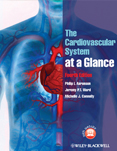-
1. What do you ask sister to do for the patient immediately?
Show Answer
You ask her to sit the patient up and start him on oxygen (initially at 5 L/min) via face mask, perform a 12-lead ECG, put the patient on a cardiac monitor and give two puffs of sublingual glyceryl trinitrate (GTN).
-
2. On arrival, you see that the patient is clammy and is wincing in pain with his fist clenched across his chest. What do you do?
Show Answer
You explain you are the on-call doctor and you ask the patient’s name. You ask where the pain is – he says in the centre of his chest. He says it feels like someone is ‘sitting on my chest’. You ask whether it radiates and he says, ‘Yes, down my left arm.’ Because prolonged use of high-flow oxygen is no longer recommended in the management of the acute coronary syndromes (ACS), you titrate his oxygen requirements according to his oxygen saturations. You briefly examine him. The ECG shows normal sinus rhythm with T wave inversion in the lateral leads and old pathological Q waves, consistent with a previous myocardial infarction. You ask one of the nurses to administer 5 mg diamorphine with 10 mg metoclopramide (an anti-emetic), give 300 mg aspirin and 300 mg clopidogrel, and then start a GTN infusion. You compare the ECG with the patient’s admission ECG and are relieved to note that there are no acute ischaemic changes. Afterwards you document everything in the patient’s notes and inform your senior.
-
3. Do you give this patient a β-blocker?
Show Answer
He has angina, is tachycardic and not in acute cardiac failure. A β-blocker is indicated in this patient, because β-blockers decrease myocardial oxygen demand and therefore limit infarct size. After checking that the patient is not asthmatic, you prescribe a dose of metoprolol.
-
4. Which ECG changes, if present, would you be most concerned about? If these were present, what would you do?
Show Answer
Blood test reveals an elevated troponin level. Given this patient’s significant cardiac history, you would be most con-cerned about new ST segment elevation, indicating acute ischaemia that would require urgent revascularization with percutaneous coronary intervention (PCI). If the ECG did show ST segment elevation or depression, you must discuss with your senior and with a cardiologist at a centre that has the capacity for PCI – in a major acute coronary event time is of the essence and he may need emergency transfer to a cardiac centre.
-
5. What is your ongoing treatment plan for this patient?
Show Answer
This patient has had an ACS. His troponin level measured 6 hours later was elevated having been normal on admis-sion. However, the ECG showed no ST segment elevation. He has therefore suffered an non-ST segment elevation myocardial infarction (NSTEMI). Remember that significant cardiac necrosis can occur without ST segment elevation. He was started on the ACS protocol of drugs: 75 mg/day aspirin and 75 mg/day clopidogrel (both antiplatelet agents) and an antithrombin such as a low molecular weight heparin or 2.5 mg/day fondaparinux. He remained on the cardiac monitor and had repeated ECGs for the duration of his hospital stay.
-
6.What is the next investigation?
Show Answer
The next investigation in patients with ACS is imaging of the coronary arteries with intervention if necessary. The question is what method of imaging and how soon. This patient’s background and positive troponin means he is at high risk of having an unstable coronary artery plaque and therefore needs prompt investigation. He underwent repeat angiography of his coronary arteries.
-
7.What is the relevance of an elevated troponin level?
Show Answer
In ACS an elevated troponin level indicates the patient has a high risk of having another coronary event soon and needs urgent further management. However, other pathologies can cause a positive troponin test and not all high risk coronary syndromes have raised troponin levels. An elevated troponin level is not diagnostic but should be considered in the context of the patient’s history, ECG and other investigations.

